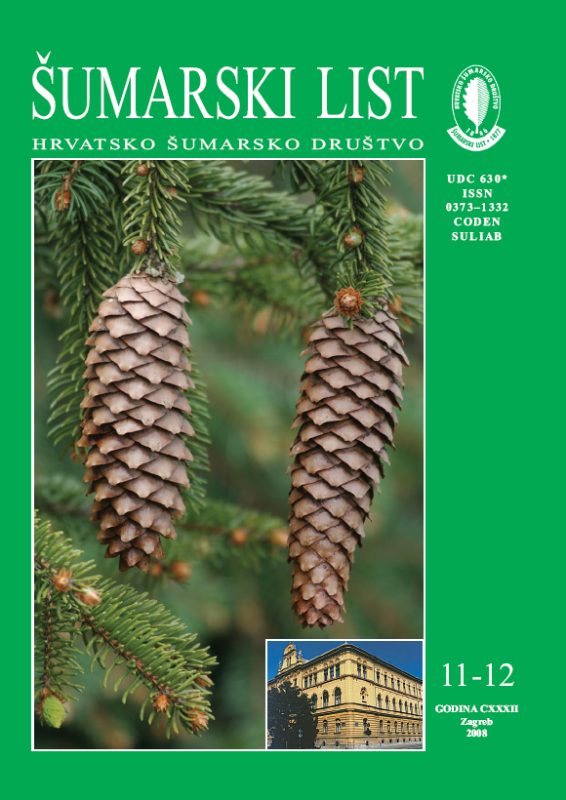
broj: 11-12/2008
pdf (7,1 MB) |
|
||||||||||||||
| RIJEČ GLAVNOGA UREDNIKA | ||
| Branimir Prpić | ||
| AT THE END OF THE YEAR PDF HR EN | 504 | |
| IZVORNI ZNANSTVENI ČLANCI | ||
| Anić, I., S. Mikac | UDK 630* 907 : 569 + 221 + 231 (001) | |
| Structure, Texture and Regeneration of Dinaric Beech-fir Virgin forest of Čorkova Uvala pdf HR EN | 505 | |
| Matošević, D. M. Pernek, M. Županić | UDK 630* 453 (001) | |
| Leafminers as Pests on Oaks (Quercus Spp.) in Croatia pdf HR EN | 517 | |
| Ivanković, M., S. Bogdan, G. Božič | UDK 630* 561 Fagus sylvatica L. (001) | |
| European Beech (Fagus sylvatica L.) Height Growth Variability in Croatian and Slovenian Provenance Trials pdf HR EN | 529 | |
| STRUČNI ČLANCI | ||
| Frković, Alojzije | UDK 630* 156 | |
| Reintroduction of Chamois in Northern Velebit pdf HR EN | 543 | |
| Summary: In tribute to the 30th anniversary of the successful reintroduction of chamois in northern Velebit, the first part of the article presents the monograph “Chamois”, written by the forester Milan Knežević and published in Sarajevo 70 years ago (1938). The book, based on the author’s own study of the Balkan chamois subspecies and imbued with love of the true hunter for the game, has not lost any of its significance and interest. The second part of the article is dedicated to the life and work of Milan Knežević (Bihać, 1879 – Zavidovići, 1944), an exceptionally talented game writer. He graduated from the Forestry Department of Technical High School in Sarajevo in 1898. Shortly after passing the state exam in 1911, he became a forest administration manager and worked in a number of forest offices across Bosnia and Herzegovina. From 1925 to 1935 he was in charge of the hunting and fishing department within the Forestry Directorate in Sarajevo. This period of his life, marked by his passionate love for hunting, nature and wildlife, proved to be the most fruitful. Despite his rough life, frequent dismissals from the service and the inability to affirm himself as an intellectual, he was a prolific hunting writer. In addition to the monograph “Chamois” and a number of articles published in Zagreb-based “Hunting-Fishing Journal”, he succeeded in completing, in cooperation with his son Ratko Knežević, his most valuable work “The Wolf – Life, Harmfulness and Extermination”, which was only published in 1956 by the Institute of Forestry and Wood Industry of Bosnia and Herzegovina. The last part of the article deals with the successful reintroduction of chamois in northern Velebit. Organized by the Republic Institute for Nature Protection in Zagreb and Forest Administration in Senj, the reintroduction was conducted on two occasions: the first time in the autumn of 1974 with 9 introduced chamois from Prenj (Bosnia and Herzegovina) and the second time four years later, on 10 October 1978, with 5 adult animals from the Kamnik Alps (Slovenia). The newly established population inhabiting the National Park of Northern Velebit and the hunting grounds “Sveti Juraj” and “Jablanac” is estimated at about 400 animals and is subjected to game management (hunting). However, despite these encouraging numbers, we cannot be satisfied with the current status of chamois in Croatia from the game hunting aspect. In the Croatian part of the Dinaric mountain range, from Gorski Kotar to the hinterland of Dubrovnik, there are vast areas that are very suitable for successful breeding of chamois; yet, these areas are completely under-utilized in this respect. According to some calculations made by competent experts who are thoroughly acquainted with the conditions in the terrain, about 70,000 ha would suffice for successful chamois breeding programes on Mt. Velebit. The major part of this area is chamois habitat of the first site class. In terms of animal number, this area could support about two thousand chamois, with an annual income of 480 animals and harvest of 250 animals (Car, 1972). The same number of chamois that were released in northern Velebit should also be released in central and southern Velebit for this purpose (Mikulić, 1982). Key words: Milan Knežević; monograph “Chamois”; northern Velebit; reintroduction of chamois | ||
| Meštrić, Branko | UDK 630* 945 | |
| Digitization of Journal of Forestry pdf HR EN | 551 | |
| Domac, J., Z. Benković, T. Starčić | UDK 630* 867 | |
| Development of a sustainable charcoal industry pdf HR EN | 555 | |


